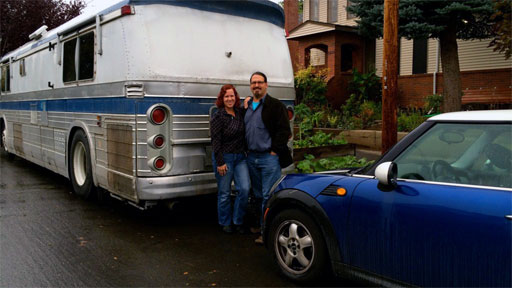“I think we should buy an RV,” Kim announced one morning late last spring. “We spend a lot of money traveling around the world. If we had an RV, we’d spend less and we could explore our own country for once. I think it’d be fun to take six months or a year to see what’s out there.”
“That’s a great idea,” I said. “I’ve always wanted to drive across the U.S. I want to see the National Parks. Plus, I want to explore all of the places I’ve never been. New England. The South. I don’t know anything about RVs though.”
“Me neither,” Kim said. “But we can learn.”
“You’re not worried about too much time in close quarters?”
“Nope,” she said. “We travel well together. Plus, we’re both good at giving the other person space when needed.”
“Let’s do it!” I said.
Despite our initial enthusiasm, we didn’t take action for a long time. Deciding to leave your normal lives to travel across the country for six months (or a year) is a major life decision. We had to stew on the idea, to savor it. We had to consider the pros and cons. We both chatted with friends and family about their experiences with RVs and trailers. We read websites and watched videos.
After a few months of research and contemplation, we were ready to put our dream into action.

Kim and I have traveled the world together; now we’ll explore the U.S.
Trailer or Motorhome?
First, we had to decide what sort of rig to purchase. We could buy either a trailer and a truck to tow it, or a self-contained recreational vehicle. Each option had its pros and cons.
- With a travel trailer and truck, we’d have a greater selection of floorplans. Trailers come in all sorts of layouts, whereas RVs tend to adhere to a few standard designs dictated by their very nature (a house on wheels). But neither of us was keen on towing — especially backing into tight spaces. Plus, we didn’t like the idea of having to constantly hitch and unhitch the trailer. Finally, we wouldn’t have access to our living quarters while we were on the road.
- A motorhome, on the other hand, would be easy to drive — especially a Class B or Class C RV (see below for explanation of RV classes). One person would have access to the living quarters while the other person drove. On top of that, we could tow my Mini Cooper to use as local transportation whenever we camped.
We decided to focus our attention on RVs instead of trailers (although we agreed not to rule out the idea of buying a truck and trailer). But what class of RV?
For those of you who are new to the world of RVs, motorhomes are divided into three distinct classes:
- Class A motorhomes tend to look like a bus. Because they tend to be large, they often feel spacious and luxurious inside.
- Class B motorhomes tend to look like a van. While they usually have everything you need — a bathroom, a kitchen, a bed — there’s not much living space inside. Class B RVs are nimble in the city, but cramped when camping.
- Class C motorhomes tend to look like a delivery truck (think U-Haul). They’re a sort of compromise between a Class A and a Class B, offering more maneuverability than a Class A and more living space than a Class B.
We weren’t sure which type of motorhome would best suit our needs. To find out, we’d have to look at a lot of coaches. Eventually, however, we learned what sort of space would best suit our lifestyle. (More about that in the next chapter of this story.)
Setting a Budget
Next, we set a budget.
New RVs aren’t cheap. It’s easy to spend $80,000 or $100,000 or $200,000 on a coach — and then, like a car, the new rig will lose 15% of its value in the first year and continue to depreciate rapidly for a decade. We knew from the start that we wanted to buy used rather than new. We wanted to minimize how much we’d lose to depreciation.
“I think we should aim to spend less than $10,000,” Kim said. But that target didn’t last long. For $10,000, we could buy a twenty-year-old fixer-upper, and that didn’t appeal to us. For a long time, we toyed with a $20,000 budget, but even then we weren’t comfortable with what we could buy. Ultimately, we doubled that figure.
“Look,” I said. “I just had a $50,000 bond mature, which means the cash is sitting there unused. Rather than flip that money into a new mutual fund, let’s use that as our RV budget. If we buy something for under $40,000 then we have $10,000 as an emergency fund in case we need to make repairs while we travel.”
I’m not going to lie: $40,000 is a lot of money, and it took me a long time to get comfortable with the idea that we’d spend that much on a vehicle. To cope with my apprehension, I had to keep telling myself that this $40,000 wasn’t money down the drain. We’d recoup most of that when we re-sold our coach after the trip. If we owned the rig for a year, we’d lose maybe $5000 to depreciation. Still a lot of money, but not nearly as bad as $40,000. (And especially not as bad as the $15,000 that we’d lose is we bought a new RV.)
Expert Advice
By October, we knew a few things: We wanted to spend six months to a year traveling across the United States and Canada; we suspected a Class C motorhome would be the best fit for us (but we were open to other options); and we had a budget of $40,000 to buy a used vehicle, although we hoped to spend less.
A few days before Halloween, I met up with Chris and Cherie, the Technomads. They’ve been living in an RV full-time for almost a decade and just happened to be in Portland when I emailed them to ask for advice. I took them to lunch and picked their brains about what it’s like to live on the road. They gave me a tour of their current home (a converted 1961 GM bus!) and talked about the pros and cons of different modes of travel.
“You first RV will be a trial vehicle, so don’t try to optimize,” Chris told me. “As you live in it, you’ll learn what you need.”
“But you should still look at lots of RVs before you buy one,” Cherie added. “Try to simulate real-life conditions. What’s it like when one of you is in the bathroom getting ready to go out? What about when one of you is working and the other is cooking? Or what about when one of you is sick? How does that affect things?”
“Usually your best bet is to buy a ten- or twenty-year-old top-of-the line motorhome,” Chris said. “The quality is important. It makes a difference.”
The Technomads gave me a list of online resources to check out, and they offered some general advice from their ten years of travel. “We figure living expenses — which means fuel and camping fees — run about $750 per month, which is about like rent in many parts of the country,” they said. “You can save money by driveway surfing and staying put for longer periods of time.”
Armed with their advice, Kim and I dove head-first into RV shopping. Our first stop? The Portland fall RV show…

{ 4 comments… read them below or add one }
Do you have a way to follow your new blog by getting an announcement via email?
Virtual hugs,
Judie Ashford
Lazy Daze Owner
(2005 Rear Bath)
The subscribe button should be fixed now, please let us know if you still have problems.
I will echo this question! How do I sign up to follow this by email? I am looking forward to following your adventures, but I know myself, if it doesn’t show up in my email, I won’t see it! Thanks!
Scott.
Hi Scott, sorry we’ve been in the “working stages” of the website, but the subscribe button should work now.